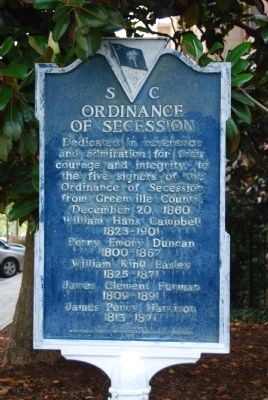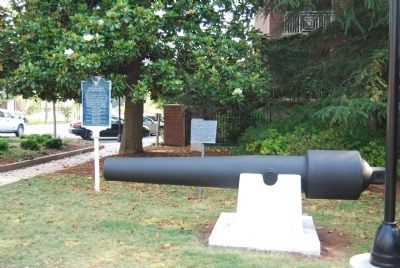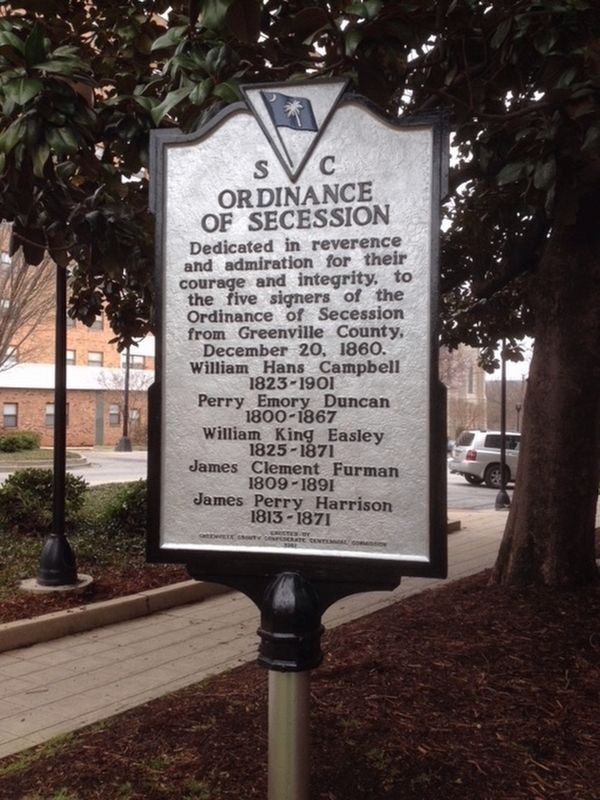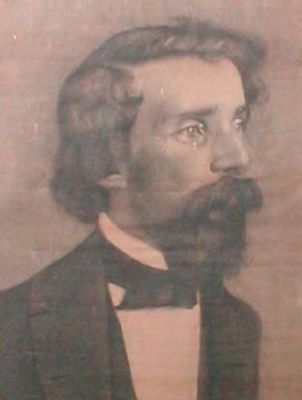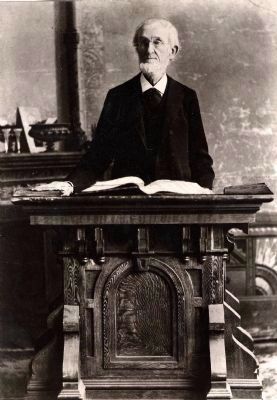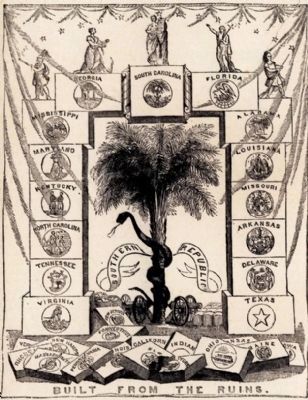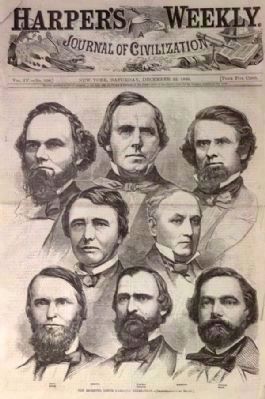Greenville in Greenville County, South Carolina — The American South (South Atlantic)
SC Ordinance of Secession
and admiration for their
courage and integrity to
the five signers of the
Ordinance of Secession
from Greenville County,
December 20, 1860:
William Hans Campbell
1823-1901
Perry Emory Duncan
1800-1867
William King Easley
1825-1871
James Clement Furman
1809-1891
James Perry Harrison
1813-1871.
Erected 1961 by Greenville County Confederate Centennial Commission. (Marker Number 23-7.)
Topics. This historical marker is listed in this topic list: War, US Civil. A significant historical date for this entry is December 20, 1860.
Location. 34° 51.32′ N, 82° 23.816′ W. Marker is in Greenville, South Carolina, in Greenville County. Marker is at the intersection of North Main Street and East Elford Street, on the right when traveling north on North Main Street. The marker is part of a park designed to remember those with military service. It is near the entrance to Springwood Cemetery. Touch for map. Marker is in this post office area: Greenville SC 29601, United States of America. Touch for directions.
Other nearby markers. At least 8 other markers are within walking distance of this marker. Confederate Armory (here, next to this marker); In Memory of 81st Wildcat Division / Camp Sevier (here, next to this marker); Kershaw Brigade (a few steps from this marker); General Robert E. Lee (within shouting distance of this marker); Greenville County Confederate Monument (within shouting distance of this marker); Springwood Cemetery (within shouting distance of this marker); Eighty Unnamed Soldiers (within shouting distance of this marker); Mrs. James Williams (within shouting distance of this marker). Touch for a list and map of all markers in Greenville.
Also see . . . William King Easley Biography. The first member of the Easley family to come to the state of South Carolina, was Robert with his wife Mary Allen, who moved to the state from Virginia. (Submitted on February 11, 2009, by Brian Scott of Anderson, South Carolina.)
Additional commentary.
1. Perry Emory Duncan
Perry Emory Duncan, was born in Greenville, South Carolina, in 1800, and married Mary Anne Hill, who was born in Wilkes County, Georgia, in 1814. Of this marriage George W. Duncan was born in Greenville, South Carolina, on February 22, 1852. He was exceedingly fortunate in his father. A man of great business
ability, Perry Emory Duncan had amassed a considerable estate. He owned a good plantation a few miles out of Greenville, had many slaves, and also operated a cotton plantation seven miles below Albany, Georgia, where the family passed the winter season. He was a strong Union man, strenuously opposed to secession, but was a member of the Convention, and when the State decided to go out threw in his lot with his compatriots and signed the ordinance of secession. He had been prominent in many ways in the State, served in the Legislature for a long period, was of recognized ability, of the highest personal character, and enjoyed the confidence and esteem of a large constituency. He gave the Confederacy a most loyal support. Too old a man to enter the army himself, being then in the sixties, he sent three of his sons, who were in active service throughout the war except when disabled by wounds or sickness. One of his sons, Robert Perry Duncan, rose to the rank of Colonel and was Chief of Staff to General R.H. Anderson, of South Carolina. Mrs. Perry Duncan organized a sewing society at Greenville for the benefit of the soldiers at the front, and as she had three sons in the Army of Northern Virginia, made constant trips, and was greatly loved by the soldiers for her many deeds of kindness. (Source: Men Of Mark In Georgia: A Complete And Elaborate History Of The State From Its Settlement To The Present Time, Chiefly Told In Biographies And Autobiographies by William J. Northen, pg 301.)
— Submitted September 14, 2009, by Brian Scott of Anderson, South Carolina.
2. James Clement Furman (1809-1891), South Carolina Baptist Leader
James Clement Furman participated in the Secession Convention in South Carolina and then ardently supported the Confederate cause through his efforts on the home front. The son of Richard Furman, an eminent South Carolina Baptist pastor and educator during the Revolutionary and Early Republic eras, and Dorothea Maria Burn, Furman worked as a Baptist pastor and educator in South Carolina. He graduated from the College of Charleston in 1826, and originally planned to pursue the medical profession. He, however, was converted during the preaching of Dr. Basil Manly, Sr., and began ministerial pursuits, preaching his first sermon and being licensed all in 1828. After studying for a time at the Furman Institution, he was ordained in 1832. The following year, he married Harriet E. Davis and began pastoring the Welsh Neck Church at Society Hill, South Carolina. When the Southern Baptist Convention was formed in May 1845, Furman participated in the inaugural convention.
His career as an educator began in December 1844, when he resigned his church to become the senior professor of the Furman Theological Institution (formerly the Furman Institution), an office that placed the leadership of the school upon him. When the institution became Furman University in 1852, he became chairman of the faculty. He also served as professor of intellectual philosophy and professor of sacred rhetoric and pastoral duties. In 1859, he accepted the position of president of the university, serving until his resignation in 1879. During the Civil war, the university closed, and Furman served as president and professor at the Greenville Baptist Female College. After his departure from Furman University, he remained active as a preacher and as the associate editor of the Baptist Courier until his death.
With the coming of the Civil War, Furman never hesitated regarding his support of secession. On 22 November 1860 at the courthouse in Greenville, South Carolina, he participated in a meeting designed to elect five candidates from the Greenville district to attend the state's Secession Convention. This district was one of the few in the state where a significant portion of anti-secessionist citizens resided. Many speeches were given that day arguing the merits of both sides, but in the end, the people elected five secessionist candidates, including Furman, to represent them in the convention to be held beginning on 17 December.
In his speech, Furman argued that the principles of the Constitution of the United States had been violated and unfulfilled by the Northern states. The government, for example, had trampled upon the principle of justice by failing to secure the property rights of the South and robbing Southerners of thousands of dollars. He cited the protective tariff system and the fugitive slave laws as examples. Abolitionist characterizations of slavery as a crime and the efforts to exclude slaveholders from the territories insulted the dignity of the Southern states, he said. Furthermore, the government had failed to uphold the domestic tranquility by allowing the dictatorial North to monopolize the oppressed South. He asserted that, "Domestic tranquility for Southern members of Congress is to play the part of a hen-pecked wight forever annoyed by a noisy vixen." Southerners could relieve their representatives by sending them to the Congress of the Southern Confederacy. Finally, Northerners had caused slaves to despise their masters, thereby creating perpetual turmoil. The election of Abraham Lincoln as president signaled continued hostility toward the South.
Furman maintained these sentiments even after Confederate losses during 1862-1863. During that time, he continued to question Northern motives for maintaining the Union, charging that the one master passion of the North was the love of money. This love was the only reason why the North desired any associations with the South. Yet, they hypocritically cloaked such desires in the love of the flag. Years later, Furman remained convinced that the North had violated the rights of the South, as well as the principles of the Constitution. At a Memorial Day address in 1880, he continued to argue the denial of self-government. He hoped that in years to come, those who had been seen as the enemies of the "best" government in the world would be heralded as the truest friends of liberty.
Furman had a great impact on Baptist life and on education in South Carolina. His primary contribution to the Civil War effort came from his leadership in bringing about secession and his attempts to maintain popular confidence in it. In the difficult years after the war, his efforts greatly aided Furman University's ability to remain open. (Source: Encyclopedia of the American Civil War: A Political, Social, and Military History by David J. Coles, David Stephen Heidler, Jeanne T. Heidler Ph.D., and Jeanne T. Heidler (2002) pgs 796-797.)
— Submitted September 15, 2009, by Brian Scott of Anderson, South Carolina.
3. Text of the South Carolina Ordinance of Secession
The State of South Carolina
At a Convention
of the People of the State of South Carolina, begun and holden at Columbia on the Seventeenth day of December in the year or our Lord one thousand eight hundred and sixty and thence continued by adjournment to Charleston, and there by divers adjournments to the Twentieth day of December in the same year –
An Ordinance To dissolve the Union between the State of South Carolina and other States united with her under the compact entitled “The Constitution of the United States of America.”
We, the People of the State of South Carolina, in Convention assembled do declare and ordain, and it is herby declared and ordained, That the Ordinance adopted by us in Convention, on the twenty-third day of May in the year of our Lord One Thousand Seven hundred and eight eight, whereby the Constitution of the United State of America was ratified, and also all Acts and parts of Acts of the General Assembly of this State, ratifying amendment of the said Constitution, are here by repealed; and that the union now subsisting between South Carolina and other States, under the name of “The United States of America,” is hereby dissolved.
Done at Charleston, the twentieth day of December, in the year of our Lord one thousand eight hundred and sixty.
[signed] D.F. Jamison Delegate from Barnwell and President of the Convention
[signatures of delegates to the convention]
Attest: Benj. J. Arthur, Clerk of the Convention
— Submitted September 15, 2009, by Brian Scott of Anderson, South Carolina.
Credits. This page was last revised on August 12, 2021. It was originally submitted on June 4, 2008, by Brian Scott of Anderson, South Carolina. This page has been viewed 3,620 times since then and 67 times this year. Last updated on April 25, 2011, by Terry Lee Rude of Greenville, South Carolina. Photos: 1, 2. submitted on June 4, 2008, by Brian Scott of Anderson, South Carolina. 3. submitted on April 2, 2018, by Randy Tucker of Greenville, South Carolina. 4. submitted on September 14, 2009, by Brian Scott of Anderson, South Carolina. 5, 6, 7. submitted on September 15, 2009, by Brian Scott of Anderson, South Carolina. • Bill Pfingsten was the editor who published this page.
